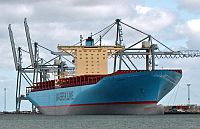 In the beginning of February, we posted about the flooding of the engine room on the Emma Mærsk, as the ship was entering the Suez Canal. The flooding put 16 feet of water in the engine room of ship, which is one of the largest container ships in the world. The flooding was reported to be caused by a failure in an aft thruster. The question of why a failure in the ship’s shaft alley would also cause such a major flooding of the engine room itself has finally been answered. Apparently, the watertight bulkhead that is designed to isolate the shaft alley from the engine wasn’t watertight. The watertight doors closed as designed but the wireway penetrations through the bulkheads are reported to have not been properly sealed, allowing the significant flooding.
In the beginning of February, we posted about the flooding of the engine room on the Emma Mærsk, as the ship was entering the Suez Canal. The flooding put 16 feet of water in the engine room of ship, which is one of the largest container ships in the world. The flooding was reported to be caused by a failure in an aft thruster. The question of why a failure in the ship’s shaft alley would also cause such a major flooding of the engine room itself has finally been answered. Apparently, the watertight bulkhead that is designed to isolate the shaft alley from the engine wasn’t watertight. The watertight doors closed as designed but the wireway penetrations through the bulkheads are reported to have not been properly sealed, allowing the significant flooding.
Having once made my living managing ship construction and repair projects, all I can say is, “oops.” It is almost inconceivable that the Odense Shipyard’s quality assurance inspectors, the owner’s inspectors and the inspectors from the American Bureau of Shipping, the classification society which classed the ship, all missed the lack of sealing of the bulkhead penetrations which would allow the sort of flooding that disabled the Emma Mærsk. The Emma Mærsk is one of eight “E-Class” 14,770 twenty-foot equivalent unit (TEU) container ships built at Odense. Mærsk has reportedly found the same lack of watertight integrity in the bulkhead penetrations on other ships in the E-Class.
A time lapse video of the construction of a new Class EEE ship. As the recent engine room flooding suggests, getting the construction right is not as easy as it looks.

“The wireways were not properly sealed” gave me the impression of missing O-rings around data cables, but that is obviously not right. Minor leaks like that would not have flooded the engine room — the pumps could have kept ahead of it. Possibly the thruster was electric, and its power cables were the ones that weren’t sealed? That would suggest much more massive holes in the watertight bulkheads. Still, another example of poor design/construction practice in the marine industry — and from a leading shipyard with a good reputation.
Hello! I just would like to give a huge thumbs up for the amazing information you’ve got here on this post. I will probably be coming back to your blog for alot more soon.
[url=http://airjordansoz.quebecblogue.com/]jordan 11[/url]
Gentlemen, I have the solution to the problem caused the Emma Maersk,’m business manager Beele Enginering in Brazil, http://www.beele.com. We are manufacturer Rise System, the single sealant for this type of ring which can prevent the entry of water, RISE SYSTEM support water pressure 4bar, fire and gas-tight.
The RISE SYSTEM has been used in several large projects of Petrobras, Brazil’s Navy, Maua shipyard, EISA shipyard, and many others.
I am at your disposal.
Julio Cesar Wanderley
julio.wanderley @ beele.cl
I have talked to a marine engineer, that have served on Emma Maersk – he told me, that there are no watertight door between engine room and the shaft tunnel on this serie of containerships – E-class.
Eigil Nielsen that engineer had never been onboard that vessel. Of course there is a watertight door between engine room and shaft tunnel.